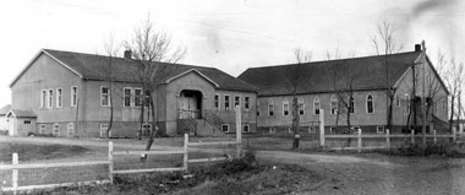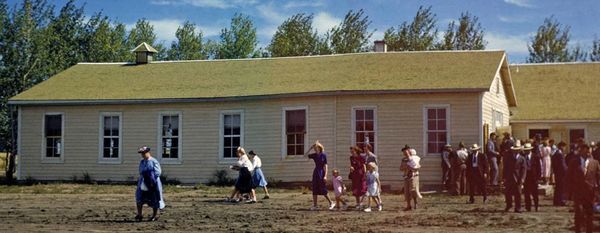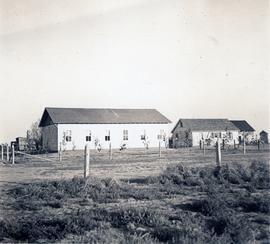Our History
Lorem Ipsum Dolor sit Amet
Client writing content, collecting resource and will populate this section.
History below have been adjusted to side-by-side grey columns to reduce real-estate and make less prominent. Green box below could also be made white to further reduce prominance. Once new content is added above it should feel much less prominent especially if the content is colourized with boxes and features.
Events leading to the Formation of Mennonite Church Alberta
(formerly Conference of Mennonites of Alberta)
by E.J. Dick
Much has been written about the history of individual churches in the province and many churches have produced their own books. The archives at the MCC Thrift Store in Calgary have copies from some congregations. In 1980 C.L.Dick compiled a book called "The Mennonite Conference of Alberta" which has submissions from various authors representing 21 churches. This presentation gleaned its information from that book. There is also a chapter dedicated to what is now called Mennonite Church Alberta.
This presentation will attempt to give you a very brief factual history of each church leading up to the formation of the Conference of Mennonites of Alberta. For detailed information your church library may be of help and the Mennonite archives at the Mennonite Historical Society of Alberta (MHSA) have a multitude of resources. As time progresses corrections will be made and more information may be added as it becomes available.
Bergthal Mennonite Church
- in 1900 the first Mennonites filed for a homestead in the Didsbury area
- by 1907 about 40 Mennonite families had settled east of Didsbury
- the Bergthal Church was was founded in 1901 under the leadership of Abram Dyck, Jacob Hamm, and Gerhard Neufeld
- the congregation did not have an ordained minister among them
- Rev. J.B. Detweiler of the Mennonite Brethren in Christ in Didsbury ministered to the group once a month
- the congregation met in homes and after 1903 they had their own church building
- Rev. Isaac Giesbrecht, of the Sommerfeld persuasion of the Mennonite church, moved into the area and took leadership in church services
- in 1910 the congregation became formally affiliated with the General Conference Church after a visit by Elder Franz Sawatzky of Herbert, Sask.
- the congregation had been served on special occasions by many men such as Rev. Boese of the Holdeman Church, Rev. David Doerksen and Rev. Abram Bergen of the Sommerfeld Church at Sunnyslope, Rev. Martens and Rev. Bender of the E.W.B. Church at Didsbury
- in 1910 Rev. Giesbrecht and a number of the Sommerfelder worshipers left the congregation
- in 1918 the church building and the graves were moved 6 miles west from the Rempel farm to where the Neufeld families lived
- the church did not have a regular minister until 1921
- ministers from other areas were asked to help such as Abram Doerksen, David Toews, Cornelius Sawatzky, Franz Sawatzky, Nick Bahnman, and George Buhler
- in 1921 Daniel Unruh, a graduate of Moody Bible Institute, came to give leadership for about 2 years
- in 1923 Mennonite immigrants from Russia came to Didsbury to join the original immigrants
- Isaac Epp, one of these new immigrants, served the church until 1925 and then moved to Saskatchewan
- in 1927 Elder C.D.Harder came from Russia and was hired as the leading minister
- he was appointed by the Canadian Conference as a travelling minister and visited every scattered group of Mennonites in Alberta and some in Saskatchewan
- in Alberta he organized at least six churches and brought them into the General Conference (Hussar, January, 1928; Macleod, July, 1928; Coaldale, August, 1928; Gem, May, 1929; Rosedale, June, 1929; Rosemary, 1930)
Burns Ranch Mennonite Church
- in the latter half of the 1920's a group of 11 Mennonite families bought 5 and _ sections of land 11 miles east of Didsbury from P.Burns Company
- the ranch buildings were located on Lone Pine Creek
- these were divided among the 11 families and moved to land allocated to each family
- regular church services were begun in the spring of 1926
- services were held in the "loft" of a building that had been used as a granary and feed storage bin
- in the winter services were held in various homes but the Christmas program was held in the "loft"
- Elder C.D.Harder of the Bergthal church was invited to meet with the "Ranch" group on December 27, 1928
- the desire was to establish a formal church organization and to join the General Conference
- in March 1929 the congregation met with Elders Harder, Janzen, and Martens to develop a constitution and choose a congregational name
- the name was Friedensort but has always been called the Burns Ranch Church
Coaldale Mennonite Church
- the first Mennonites came to Coaldale in 1927
- from 1927 to 1929 twenty-eight farms were settled by Mennonites of General Conference and Mennonite Brethren affiliation
- the two groups worshiped together and assisted one another
- the only minister was P.P. Dyck
- on February 19, 1928, P.P.Dyck called a meeting to discuss the formal organization of a General Conference church
- on August 5,1928 the Coaldale congregation officially became a General Conference Church
- the next year P.P.Dyck moved to Rosemary
- Jacob Gerbrandt, a conference minister, was in Lethbridge working for the Immigration Department
- the Coaldale church approached him to take on the leadership and he accepted but stayed only for a short time
- in 1929 Frank W. Dyck, an elected minister, came from Harris, Sask. to Coaldale
- the same year, Johann Vogt,another elected minister, came from Saskatchewan to Coaldale
- Peter Schellenberg, elected and ordained in Russia, came to Coaldale from Saskatchewan in 1930
Gem Mennonite Church
- a close relationship existed between the Gem and Rosemary churches
- 32 families had settled in the Gem area in 1929
- in 1929 it was decided to organize the church in Gem but nothing came of that decision at that time
- on February 6, 1930, the decision was made to be affiliated with the Rosemary Church
- they worshiped for a short time with the Brethren Mennonites and then met independently in the local school
Rosemary Mennonite Church
- the C.P.R. encouraged Mennonites to come to Rosemary to take up the farms recently abandoned by the original American and French Canadian farmers
- this decision was based on the reputation of the Mennonites in the Duchess area
- they were provided with some farm implements, horses, livestock, seed grain, and other essentials
- the first Mennonites came to the Rosemary area in 1926, and by 1935 about 81 families had settled in the Gem, Countess, and Rosemary communities
- three centers of worship were established in 1930
- the group at Gem met in the school but remained members of the Rosemary Church
- the group at Countess met at Clemenceau School with the Mennonite Bretheren
- the largest center of worship was in Rosemary and they met in a school
- in 1930 the C.P.R. gave the Mennonites an unfinished barn about 1 mile north of the village
- the Rosemary Church was organized and became a member of the General Conference on February 6, 1930 under the guidance of Elder C.D.Harder
- the first minister was H.H. Janzen who was among the first settlers and had been ordained in Russia
- in 1930 two other ministers settled in the area; P.P.Dyck and A. Paetkau
- in 1930 Elder C.D. Harder moved from the Bergthal Church at Didsbury to Rosemary and was immediately elected to the leadership of the congregation
- the official name of the church was Westheimer Mennoniten Gemeinde bei Rosemary, Canada
Springridge Mennonite Church
- the settlers who came to the Pincher Creek area had immigrated from Russia between 1926 and 1928
- they represented General Conference and Mennonite Brethren affiliations
- the congregation was originally called the Blumenthaler Mennoniten Gemeinde
- On July 29,1928 Elder C.D.Harder was invited to help the congregation organize into a formal group
- David Janzen, who was ordained in Russia, was selected as the leader
- Frank Gietz and John Goertz were appointed to assist him
- John Poettcker, elected but not ordained in Russia, was ordained in 1929
- in 1932, Elder C.D.Harder ordained David Janzen as Elder of the Blumenthal Church
- the first Mennonite group to come to the Tofield area were the Old Mennonites
- many of the Russian Mennonites that came in 1924-25 were welcomed by the Salem Mennonites and some were employed as farm workers
- in the fall of 1929 D. Heidebrecht, who had been ordained in Russia, came to Tofield and took on the leadership role
The towns of Munson, Rosedale, Chinook, Sedalia, New Brigden, Lacombe, and Namaka had groups of Mennonites from several denominations. For the most part they did not have their own ministers so ministers from different Mennonite denominations would visit them and conduct services. As a spiritual community they met in homes for the various kinds of activities. Elder C.D. Harder visited these groups as a travelling minister for the Canadian Conference but none of them were organized as churches and brought into the Canadian Conference.



